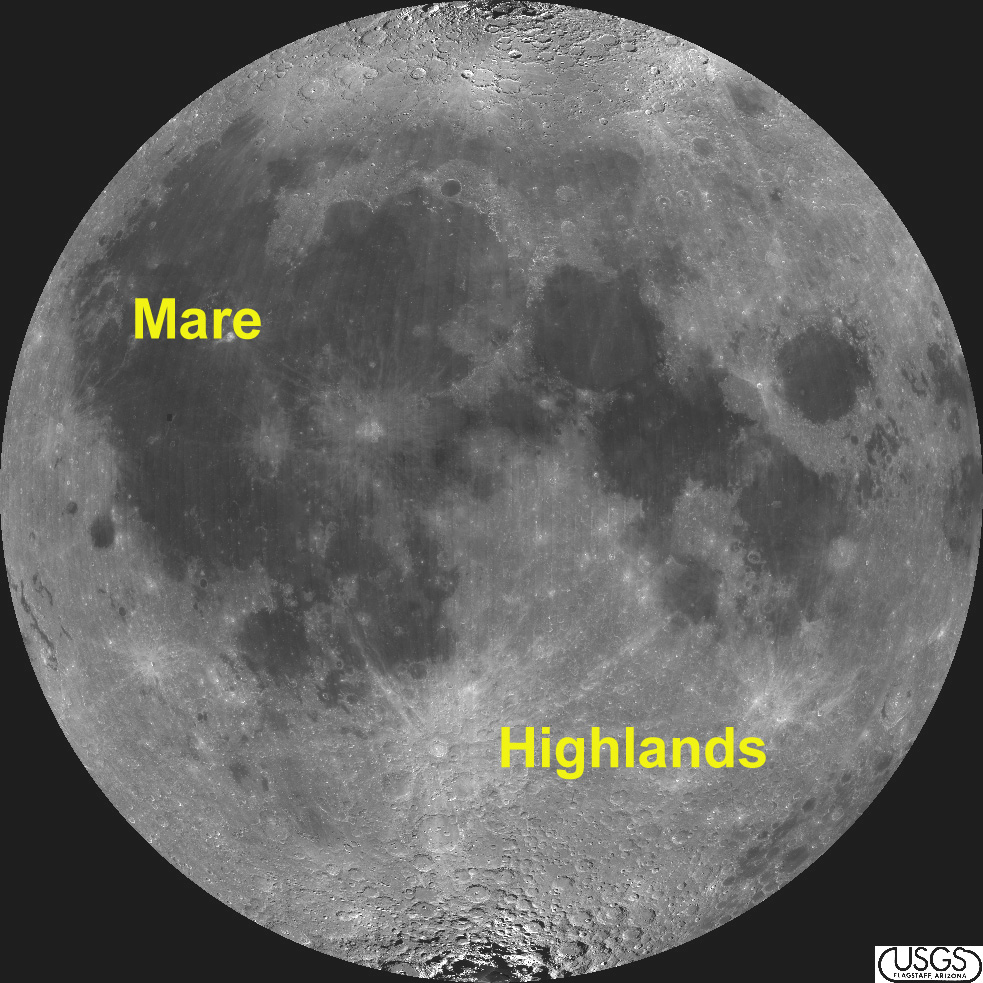Each planet in
our solar system has unique properties that provide clues to the formation of the system
The Moon
Key points: Origin of Moon; age of moon;
cratering history
 |
"Praised
be Diana's fair and harmless light, Praised be the dews wherewith she moists the ground,
Praised be her beams, the glory of the night; Praised be her power, by which all powers
abound..."
--
Sir Walter Raleigh
"That
orbed maiden
With
white fire laden
Whom mortals call the Moon."
--
Shelley
"the
moon is no maiden, but a scarred and wrinkled crone; she is not white, and she bears no
fire."
--
Cecelia Payne-Gaposchkin, "Introduction to Astronomy," 1954 |
 Holds a special place as
the only body other than Earth to have been visited by humans.
Holds a special place as
the only body other than Earth to have been visited by humans. (reload page to restart animations)
(reload page to restart animations)
(Astronaut
Aldrin from http://images.ksc.nasa.gov/photos/1969/captions/AS11-40-5903.html;
footprint
from http://us.st11.yimg.com/us.st.yimg.com/I/skyimage_1920_9141155
panorama
from Apollo 15 crew, NASA, via APOD, http://antwrp.gsfc.nasa.gov/apod/ap040113.html


Earth/Moon System
Earth formed by accretion of many small bodies. We believe the
moon formed when a large body struck the early Earth. All other theories have significant
problems:
If the earth and moon had formed together as a double planet, they
should have similar densities, contrary to observation. If the earth split during
formation, we have no good explanation of why. If the moon formed elsewhere and was later
captured by the earth, we cannot explain where the orbital energy of the moon went.
 |
A glancing blow by a large body
shatters Earth (illustration from Joe
Tucciarone http://www.monkeytime.com/sciencemaster/galleries/jt_space/gallery.php)
Much of the material broken away from the earth
goes into orbit. The moon reassembles in this orbit - it takes about a month of violent
collisions.
Earth is speeded up in rotation as a result of
the collision.
This theory is consistent with: 1.)
composition of lunar rocks, which is similar to the composition of the crust of the earth;
2.) evidence that the moon had a molten surface for 200 million years; and 3.) the lack of
magnetic field for the moon, which together with its low density implies it has very
little iron in its core. See it in action! (caution,
large file: 20 MB - do not try with slow internet connection)  (reload this page to restart lecture
animations)(movie from Eiichiro Kokubo, http://yso.mtk.nao.ac.jp/~kokubo/moon/kit/movie.html) (reload this page to restart lecture
animations)(movie from Eiichiro Kokubo, http://yso.mtk.nao.ac.jp/~kokubo/moon/kit/movie.html)
|
Measure age from radioactive decay of uranium 238 to lead
(uranium 238 is an isotope of uranium ):
):
the "half life" for this decay is 4.5 billion yrs ( half-life
is the time it takes for half of the decaying material to turn into its final state).
Molten rock removes lead from uranium, so the time since a rock
solidified can be determined from uranium vs. lead content.
Example (animation by G. Rieke):
Moon rocks brought back by the astronauts have proven to be better for
measuring ages than Earth rocks because the moon is not active geologically ( no plates,
no volcanoes, no cycling of the surface though hotter, deeper regions). Thus, the oldest
rocks still lie on the surface, rather than having been destroyed or buried deep inside.
The oldest Moon rocks have an age of nearly 4.5 x 109 years.
We think that this is essentially the same as the age of the earth and only slightly less
than the age of the Solar System.
Cratering History
 |
Earth has also been hit with meteors that formed craters
but only the most recent impact sites (like Meteor Crater in northern AZ) are still
visible -- erosion and geologic processes have removed all traces of most cratering on the
earth’s surface. (from David Hathaway, NASA/MSFC, http://science.nasa.gov/ssl/pad/solar/tutorials/lessons/craters.htm) |

 Holds a special place as
the only body other than Earth to have been visited by humans.
Holds a special place as
the only body other than Earth to have been visited by humans.





 (from Meteor Crater Enterprises,
(from Meteor Crater Enterprises, 




